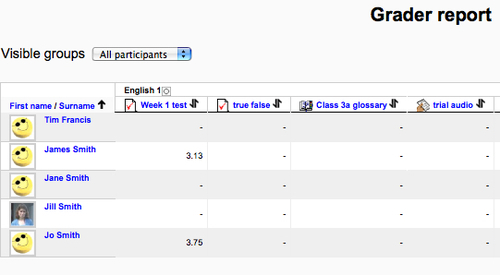The Moodle Gradebook provides a wealth of information about student grades. To access the Gradebook, click on Grades in the Administration menu on the course page.
The default view will be something like this, depending on how many quizzes and assignments you have in your course.

At a glance you can get an overview of individual grades with the option to see averages, group scores, ranges (the range of scores generated by students on a given scale), and Outcomes.
If you click on an activity (for example, Week 1 test in the graphic on the previous page), you can then get the following information:

|
Gradebook item |
Description |
|---|---|
|
Info |
Gives you the description of the item that you wrote. |
|
Results |
Gives you the chance to regrade or manually grade results. |
|
Item analysis |
Gives you statistics about questions you wrote. For example:
|
Here's what we get if we click on Item analysis:

Here's a reminder of what those terms stand for...



